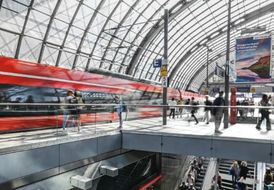Management approach and targets
High product quality is one of the most important prerequisites for implementing our Strong Rail strategy. The greatest levers for improving product quality include high levels of punctuality, the use of modern vehicles, reliable and comprehensive customer and transport information, the quality and reliability of the services offered and appropriate transport and transport times. That is why we continually invest in our fleet and infrastructure, and optimize cooperation with our suppliers and sector partners. We are also intensively exploiting the opportunities offered by digitalization.
Improving punctuality is particularly important as it is the key factor influencing customer satisfaction and therefore makes a positive contribution to meeting our customer needs, even in the context of increasing mobility needs. Only if trains and buses operate sustainably with a high degree of punctuality will passengers use rail transport for their private and work-related journeys in the long term, thereby guaranteeing the success of society’s shift in the mode of transport. Punctuality is also the key factor in the stability of production systems. In the long-distance and freight transport sectors especially, delays lead to impaired vehicle and personnel cycles, which in turn have a negative effect on maintenance delivery. This ties up the capacity and resources that are urgently needed for the desired growth in traffic in both passenger and freight transport. From an economic point of view, a high level of punctuality also minimizes the risk of penalty payments in contracted local passenger transport as well as compensation via passenger rights in long-distance passenger transport.
The importance of punctuality is also demonstrated by the fact that it is a determining factor in the amount of the variable remuneration received by executives.
Improving punctuality requires continuous internal management, on the basis of lost units (number of delays) and additional key figures, which take into account network capacity and availability, among other things. To measure punctuality, we compare the target arrival time to the actual arrival time for every train/bus run. A stop is considered on time if the scheduled arrival time is exceeded by less than six minutes in passenger transport or less than 16 minutes in freight transport. We use a punctuality rate to summarize the arrival of trains/buses on schedule or up to a defined maximum delay. Punctuality data is recorded daily and made available to managers and employees together with the lost units and other management key performance indicators. The performance is compared with the targets derived from the strategy in order to identify both negative deviations and positive developments in a timely manner.
The development of the management key performance indicators is presented as part of cascading performance dialogs within and across business units, Management Board and Supervisory Board meetings, as well as management reports to the Management Board and Supervisory Board, in order to set baselines for improvement and to derive focused decision-making needs and countermeasures. In addition, the progress of the agreed measures and the effectiveness of the measures are continuously demonstrated on the basis of further performance progress.
DB Group has made a clear commitment to further develop product quality by defining long-term punctuality targets for long-distance rail passenger transport, regional rail passenger transport and rail freight transport within the framework of the Strong Rail strategy. In order to take into account this commitment and the obligation of corporate planning with regard to quality, the primary measures to ensure the achievement of targets are set annually in the medium-term and long-term planning and approved by the Management Board.
In addition to the various aspects of product quality, the continuous optimization of the price-performance ratio and product innovations, especially in digitalization, are key levers for increasing customer satisfaction. We work extremely hard on our basic service and focus on optimizing product and service quality. We offer our customers a comprehensive range of services for their information needs. Our target is to provide our products at a reasonable price-performance ratio in order to meet the expectations of our customers. The focus is on measures that increase the quality of our services and the efficiency of our processes.
In order to assess the success of our measures from our customers’ perspective, we use direct indicators such as revenues, the number of passengers and satisfaction during the customer journey. In addition to this, we use the results of regular customer surveys to measure our success and find potential areas for improvement.


